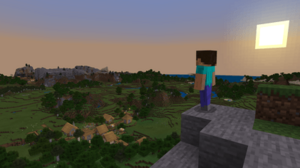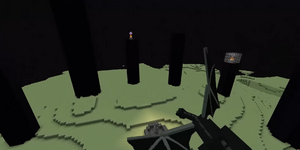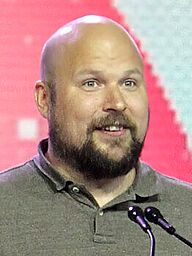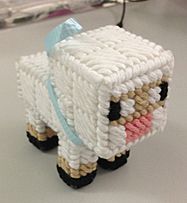Minecraft facts for kids
Quick facts for kids Minecraft |
|
|---|---|

Cover art since 2024
|
|
| Developer(s) | |
| Publisher(s) |
|
| Designer(s) | |
| Artist(s) |
|
| Composer(s) |
|
| Series | Minecraft |
| Platform(s) | |
| Release date(s) |
18 November 2011
Linux, Mac OS X, Windows
Android
iOS
Linux, Mac OS X, Windows
Xbox 360
Raspberry Pi
PlayStation 3 Fire OS
PlayStation 4
Xbox One
PlayStation Vita Windows Phone
Windows 10
Wii U
Android, iOS, Windows 10, Fire OS, Windows Phone, tvOS, Fire TV
Nintendo Switch
New Nintendo 3DS
ChromeOS
PlayStation 5
Xbox Series X/S
|
| Genre(s) | Sandbox, survival |
| Mode(s) | Single-player, multiplayer |
Minecraft is a super popular sandbox game made by Mojang Studios. It first came out on November 18, 2011, for computers. Before that, an early version was available in May 2009. Since then, it has been released on many different devices, like phones and game consoles.
In Minecraft, you get to explore a huge, three-dimensional world that is always new and different. This world is made up of voxels, which are like building blocks. You can find and collect materials, then use them to craft tools and other items. You can also build amazing structures, dig tunnels, and even create machines!
Depending on how you want to play, you can fight against computer-controlled creatures called mobs. You can also play with friends or compete against them in multiplayer games. The Minecraft community is huge and creative! Players make all sorts of extra content, like modifications (mods), special servers, unique player skins, texture packs, and custom maps. These additions bring new ways to play and explore.
Markus Persson first created Minecraft in 2009 using the Java programming language. After the game's full release in 2011, Jens Bergensten took over its development. In 2014, Microsoft bought Mojang and Minecraft for a lot of money. Now, Xbox Game Studios helps publish the Bedrock Edition, which is a version that works on many different devices. The Bedrock Edition and the original Java Edition both get regular updates, keeping the game fresh and exciting.
Minecraft is the best-selling video game of all time, with over 350 million copies sold by 2025. It has won many awards and is considered one of the greatest video games of all time. Things like social media, funny parodies, cool merchandise, and yearly conventions called Minecon have made the game even more famous. Many kids from Generation Z grew up playing Minecraft, making it a big part of their childhood. The game is even used in schools to teach subjects like chemistry, computer-aided design, and computer science. The Minecraft world also includes other games, like Minecraft: Story Mode, Minecraft Dungeons, and Minecraft Legends. A live-action movie, A Minecraft Movie, came out in 2025 and was a huge hit!
Exploring the World of Minecraft
Minecraft is a 3D sandbox game with no set goals. This means you have lots of freedom to play however you like! There are also optional challenges you can try to complete. You usually play in a first-person view, but you can switch to a third-person view if you prefer.
The game world is made of 3D blocks, which represent different materials like dirt, stone, wood, water, and lava. The main idea is to pick up and place these blocks. You can move freely around the world, mining blocks and then placing them somewhere else to build things. Most blocks stay where you put them, not falling due to gravity.
You can also craft many different items. These include armor to protect you from attacks, weapons like swords and bows and arrows to fight monsters, and tools like pickaxes and shovels to break blocks faster. Some items are better and last longer depending on the materials you use to craft them. You can also craft useful blocks like furnaces to cook food and torches to make light. Sometimes, you can even trade items with villagers using emeralds!
You have an inventory to carry a limited number of items. The game has a day and night cycle, with each full cycle lasting 20 real-time minutes. There's also a special material called redstone. You can use redstone to build simple machines, electrical circuits, and even logic gates for complex systems.
When you start, you get a random character skin, like Steve or Alex. But you can also create and upload your own! You'll meet different creatures called mobs. Friendly mobs like cows, pigs, and chickens appear during the day. You can hunt them for food and materials. Hostile mobs, like large spiders, witches, skeletons, and zombies, appear at night or in dark places like caves. Some hostile mobs, like zombies and skeletons, burn in the sun unless they have headgear or are in water.
Unique Minecraft creatures include the creeper, which explodes when it gets close, and the enderman, which can teleport and move blocks. There are also different types of mobs depending on where you are.
How Worlds are Created
The Minecraft world is created automatically as you explore it. It uses a special "map seed" that is chosen when you start a new world. The world is divided into different biomes, which are like different environments with unique resources and structures. These worlds are designed to feel endless, though there are technical limits.
Long ago, if you traveled very far, the world would start to look strange with wall-like patterns. This was called the "Far Lands." Now, there's a special barrier called the world border, about 30 million blocks away, that stops you from going too far. The vertical space is limited, with unbreakable bedrock at the bottom and a building limit high in the sky.
Different Dimensions to Explore
Minecraft has three main dimensions you can visit through special portals. Each dimension offers a different environment.
The Overworld is where you start. It's like the real world, with plains, mountains, forests, oceans, and caves.
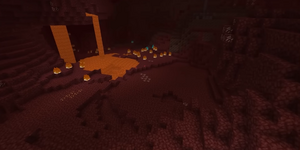
The Nether is a fiery underworld, like a dangerous cave, accessed through an obsidian portal. It's mostly made of lava. You'll find mobs like shrieking, fireball-shooting ghasts, and piglins (anthropomorphic pigs). Piglins will trade items with you if you give them gold. You can also find Nether Fortresses, which have mobs like wither skeletons and blazes. You need blaze rods from blazes to reach the End dimension. You can also build a powerful boss called the Wither using skulls from wither skeletons.
The End is a dimension of floating islands in a dark void. You reach it through an end portal found in underground strongholds in the Overworld. You need "eyes of ender" to find these strongholds and activate the portal. A huge boss called the Ender Dragon guards the main island. If you defeat the dragon, an exit portal appears. Going through it shows the game's ending credits and a special poem. After the credits, you return to your world and can keep playing forever!
Ways to Play: Game Modes
Survival Mode: Build and Survive
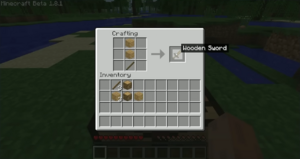
In Survival mode, you must gather resources like wood and stone to craft items and blocks. Monsters appear in dark areas at night, so you need to build a shelter to stay safe. You have a health bar that goes down if you get hurt by mobs, falls, lava, or other dangers. You also have a hunger bar, which you fill by eating food. If your hunger bar is empty, you start to starve. Your health goes up when your hunger bar is full or if you play on peaceful difficulty.
If you lose all your health, you die. You drop all the items in your inventory, but you can usually get them back if you reach them within 5 minutes. You respawn at your starting point or at a bed you've slept in. You earn experience points (XP) by killing mobs, mining, cooking, and breeding animals. You can use XP to enchant your tools, armor, and weapons, making them more powerful.
There are two other modes based on Survival: Hardcore and Adventure. Hardcore mode is like Survival but much harder, and if you die, your world is gone forever (or you can explore it as a spectator). Adventure mode is for playing custom maps, where the map creator sets rules about how you can interact with the world.
Creative Mode: Build Anything!
In Creative mode, you have unlimited access to all items and blocks in the game. You can place or mine them instantly. You can also fly freely around the world. Your character doesn't take damage or get hungry. This mode is perfect for focusing on building huge projects without any interruptions.
Playing with Friends: Multiplayer
Multiplayer in Minecraft lets many players interact and build together in the same world. You can play with friends through direct connections, on a local area network (LAN), or on special servers. You can even host your own server or join others through services like Xbox Live, PlayStation Network, or Nintendo Switch Online.
Minecraft multiplayer servers are managed by operators. They can change the time of day or teleport players. They can also set rules for who can join. Some servers have unique games and customs. Hypixel is one of the largest and most popular servers, with millions of players visiting it. You can also enable Player versus player combat (PvP) to fight against other players.
Minecraft Realms: Easy Private Servers
In 2013, Mojang launched Minecraft Realms. This service makes it easy and safe for players to run private multiplayer games without needing to set up their own servers. Only invited players can join Realms servers. Minecraft: Java Edition Realms let up to twenty people play, with ten online at a time. Minecraft Bedrock Realms also allow up to ten players online at once.
Java Edition Realms don't support user-made plugins, but you can play custom maps. Bedrock Realms support user-made add-ons, resource packs, and custom maps. By June 2016, Realms allowed players on Windows 10, iOS, and Android to play together. Support for Xbox One and Nintendo Switch was added later in 2017 and 2018.
Customizing Your Game: Modifications and Marketplace
The modding community is made up of fans and programmers who create extra content for Minecraft. They make things like modifications (mods), texture packs, and custom maps. Mods add new gameplay changes, such as new blocks, items, mobs, or even entire systems. Some mods make gameplay better, like adding mini-maps, while others bring elements from other games.
Mojang has also added official ways to customize the game, like resource packs that change textures and sounds. Players can create their own "maps" (custom worlds) with specific rules, challenges, or puzzles, and share them. Mojang added adventure mode and "command blocks" specifically for custom maps in Java Edition. Data packs, added in version 1.13 of the Java Edition, allow even more customization, including new achievements and world generation.
Console versions, like the Xbox 360 Edition, supported downloadable content (DLC) like character skins and texture packs. These were often themed after other popular games. Unlike Java Edition, console versions didn't support player-made mods. In 2016, a special Super Mario resource pack was released for the Wii U Edition and later for the Nintendo Switch Edition. In April 2018, a problem was found with some user-made Minecraft skins for Java Edition, but Mojang quickly fixed it.
The Minecraft Marketplace
In June 2017, Mojang released the "Marketplace" for the Pocket Edition (which later became the Bedrock Edition). The Marketplace is a store where you can buy user-made content. This allows Minecraft creators to earn money from their work. You can buy skins, maps, texture packs, and add-ons using "Minecoins," which you buy with real money. There's also a "Marketplace Pass" subscription for access to specific content. The Marketplace also features items from Mojang, Microsoft, and official collaborations with other popular brands. By 2022, the Marketplace had over 1.7 billion content downloads and earned over $500 million.
How Minecraft Was Made
Before Minecraft, Markus "Notch" Persson worked as a game developer. He often created his own game ideas in his free time, inspired by other games. One of his projects was "RubyDung," a building game. He was also inspired by Infiniminer, another block-based mining game. Infiniminer helped shape Minecraft's blocky look and first-person view.
The first public version of Minecraft was released on May 17, 2009. Over the years, Persson regularly added new features like tools, mobs, and new dimensions. In 2011, because the game was so popular, Persson decided to release the full 1.0 version on November 18, 2011. Soon after, Persson stepped down, and Jens "Jeb" Bergensten became the lead developer.
On September 15, 2014, Microsoft, the company behind Microsoft Windows and Xbox, announced they were buying Mojang and Minecraft for $2.5 billion. Persson had suggested the idea on Twitter. The deal was completed on November 6, 2014.
After 2014, Minecraft received major updates, usually once a year, each with a specific theme. For example, the 1.13 Update Aquatic focused on ocean features, and the 1.16 Nether Update changed the Nether dimension. However, in late 2024, Mojang decided to release smaller updates more often. The Bedrock Edition also gets regular updates that match the Java Edition themes. Other older versions of the game, like some console editions, were either combined into Bedrock or stopped receiving updates.
On May 7, 2019, for Minecraft's 10th anniversary, an old 2009 version called Minecraft Classic was made available to play online for free. In April 2020, a special beta version for Bedrock Edition, called Minecraft RTX, was released. It added realistic lighting and reflections for computers with special graphics cards. A new visual mode called Vibrant Visuals was announced on March 22, 2025. It offers modern graphics features without needing special hardware. Vibrant Visuals was released for Bedrock Edition on June 17, 2025, and is scheduled to arrive on Java Edition later.
Different Versions of Minecraft
Java Edition: The Original
Development for the original Minecraft, first called Cave Game and now known as the Java Edition, began in May 2009. Markus Persson released a test video of an early version on YouTube. The game was first called Minecraft: Order of the Stone but was soon shortened to just Minecraft.
Private testing began on May 16, 2009, and the first public version was released on May 17, 2009. This early version became known as Classic. More development phases, like Survival Test, Indev, and Infdev, were released in 2009 and 2010.
The first big update, Alpha, came out on June 30, 2010. Persson later quit his day job to work on Minecraft full-time as sales grew. Updates were automatic and added new blocks, items, and game changes. With the money from the game, Persson founded Mojang, a video game studio.
On December 11, 2010, Persson announced that Minecraft would enter its beta phase on December 20. He promised that bug fixes and pre-release updates would remain free. Mojang hired more people as the game grew.
The game officially left beta and fully launched on November 18, 2011. On December 1, 2011, Jens "Jeb" Bergensten took over as the lead designer.
Pocket Edition and Bedrock Edition
In August 2011, Minecraft: Pocket Edition was released for Android phones, and later for iOS in November 2011. This version was written in C++ instead of Java. It focused on building and basic survival but didn't have all the features of the PC version at first.
A version for Windows Phones was released in December 2014. In July 2015, a Windows 10 Edition was released, allowing cross-play with other Pocket versions. In January 2017, Microsoft stopped supporting the Windows Phone versions. On September 20, 2017, the "Better Together Update" brought Pocket Edition to Xbox One and renamed it the Bedrock Edition.
The Bedrock Edition later came to Nintendo Switch and PlayStation 4. The PlayStation 4 version received the update in December 2019, allowing players to play across different platforms with a free Xbox Live account. A native Bedrock Edition for PlayStation 5 was released on October 22, 2024, and for Xbox Series X/S on June 17, 2025. Older console versions, like for PlayStation 3 and Xbox 360, received their final updates in December 2018 and are now called "Legacy Console Editions." The New Nintendo 3DS version also received its final update in January 2019.
Other Special Versions
Minecraft Education
An educational version of Minecraft, made for schools, launched on November 1, 2016. It's available on many devices like Android, ChromeOS, iPadOS, iOS, MacOS, and Windows. It helps teachers use Minecraft in their lessons.
China Edition
On May 20, 2016, the China Edition (also known as My World) was announced for China. It was released for PC in August 2017, and for iOS and Android in September and October 2017. The PC version is based on the Java Edition, while the mobile versions are based on the Bedrock Edition. This version is free to play and had over 700 million registered accounts by September 2023.
Minecraft for Windows
This version of Bedrock Edition is only for Microsoft's Windows 10 and Windows 11 computers. It was first released as a beta in July 2015 and fully launched in December 2016. On June 7, 2022, the Java and Bedrock Editions for Windows were combined into one purchase. If you owned one, you got the other for free, but they still remained separate games.
Different Ways to Experience Minecraft
Virtual Reality Minecraft
Markus Persson originally planned to support the Oculus Rift VR headset. However, he changed his mind after Facebook bought Oculus. In 2016, fans created a mod called Minecraft VR for Java Edition. Later that year, Microsoft added official Oculus Rift support for Windows 10 Edition. There's also a version for Gear VR. Windows Mixed Reality support was added in 2017. On September 7, 2020, Mojang announced that the PlayStation 4 Bedrock version would get PlayStation VR support. However, in September 2024, the Minecraft team announced they would no longer support PlayStation VR, with its final update released in March 2025.
The Sounds of Minecraft

The music and sound effects for Minecraft were created by a German musician named Daniel Rosenfeld, also known as C418. He used many creative ways to make the sounds. For example, to make the sound of walking on grass, he didn't record actual grass. Instead, he broke apart a VHS tape and lightly touched the tape! He said his favorite sound to design was the spider's hiss. He researched what spiders sound like and then used a recording of a fire hose, changing its pitch until it sounded like a strange spider.
Many sound decisions happened by accident. The creeper's famous hissing sound before it explodes was originally just a placeholder sound of a burning matchstick. It worked so well that they kept it! Rosenfeld also made the zombies sound a bit comical, not too scary.
The background music in Minecraft is calm and instrumental. Rosenfeld used special software and synthesizers to compose it. He released two official soundtracks: Minecraft – Volume Alpha in 2011 and Minecraft – Volume Beta in 2013. These albums include most of the game's music.
C418 worked on the music until the 1.13 Update Aquatic in 2018. After that, new composers like Lena Raine, Kumi Tanioka, Aaron Cherof, and Amos Roddy started adding music. Lena Raine is now the main composer.
Minecraft in Pop Culture
Minecraft has had a huge impact on culture. In September 2019, The Guardian called it the best video game of the 21st century so far. In November 2019, Polygon said it was the "most important game of the decade." In June 2020, Minecraft was added to the World Video Game Hall of Fame. It was also one of the first successful games to let people buy and play early versions to help fund its development.
Social media, especially YouTube, Facebook, and Reddit, helped make Minecraft famous. Many players learned about the game from online videos. Minecraft videos, often made by commentators showing their creations or giving tips, became very popular on YouTube. By May 2012, over four million Minecraft videos had been uploaded. The game was a huge part of YouTube's gaming scene throughout the 2010s. In 2014, it was the second-most searched term on the platform.
Famous YouTubers like The Yogscast and Jordan Maron (CaptainSparklez) created many popular Minecraft videos and music parodies. In 2019, thanks to PewDiePie's playthroughs, Minecraft saw another big surge in popularity on YouTube. By December 2021, the total views for Minecraft-related videos on YouTube had passed one trillion!
Minecraft has been referenced in other video games like Torchlight II and Team Fortress 2. The character Steve is even a playable fighter in Super Smash Bros. Ultimate, with moves inspired by Minecraft's building and crafting. The game was also featured in an episode of the TV show South Park. In 2025, A Minecraft Movie was released and broke box office records for a video game movie.
Real-World Uses for Minecraft
People have discussed using Minecraft for many things, especially in computer-aided design (CAD) and education. At Minecon 2011, a developer talked about using the game to redesign public buildings and parks. He said it was easier for communities to imagine new designs using Minecraft. In 2012, an expert from MIT Media Lab said, "Notch hasn't just built a game. He's tricked 40 million people into learning to use a CAD program."
In September 2012, Mojang started the Block by Block project with UN Habitat. This project uses Minecraft to help young people design changes for their own neighborhoods. Citizens can join Minecraft servers and modify their local areas. Mojang's managing director, Carl Manneh, called the game "the perfect tool" for this. The project aimed to improve 300 public spaces by 2016.
In April 2014, the Danish Geodata Agency created a full-scale model of all of Denmark in Minecraft using their own map data. This was possible because Denmark is a very flat country.
The organization Reporters Without Borders used an open Minecraft server to create the Uncensored Library. This library within the game holds journalism from authors in countries where their work is censored. The virtual building was created by an international team over 250 hours.
Despite its unpredictable nature, Minecraft speedrunning is very popular. Players race to defeat the Ender Dragon boss as fast as possible after starting a new world. Some speedrunners use mods, while others play the game in a more traditional way.
Minecraft in Schools
Minecraft is used in schools through programs like MinecraftEdu, started in 2011. This made the game affordable for schools. MinecraftEdu allowed teachers to track student progress. By 2012, about 250,000 students worldwide used the platform. Mojang also developed Minecraft: Education Edition with ready-made lesson plans for classrooms.
Teachers use Minecraft to teach subjects like history, language arts, and science. They create custom worlds, like reconstructions of historical places or large models of animal cells. Redstone blocks have even been used to build virtual machines, like a hard drive and an 8-bit computer. Mods have been made to teach programming using these mechanics. In 2014, the British Museum announced a project to rebuild its building and exhibits in Minecraft with public help. Microsoft and Code.org offer Minecraft-based tutorials to teach programming. By 2018, over 85 million children had used these resources. In 2025, the Musée de Minéralogie in Paris held an exhibition called "Minerals in Minecraft."
Other Games Like Minecraft
After Minecraft became popular, many other video games were made that looked similar. Some were called "clones" because they were directly inspired by Minecraft. Examples include Ace of Spades, Terraria, and FortressCraft. Even Markus Persson made another similar game called Minicraft in 2011. In 2025, Persson considered making a new game similar to Minecraft, but he later canceled those plans.
In November 2024, companies released Oasis, an AI-generated version of Minecraft. In this game, everything is created by AI in real time, which can sometimes lead to unexpected things appearing or disappearing.
Minecon and Fan Events
Minecon was an annual official fan convention for Minecraft. The first big Minecon was held in November 2011 in Las Vegas. It included the official launch of Minecraft, speeches, building contests, costume contests, and chances to meet Mojang employees. In 2016, Minecon was held in person for the last time. After that, yearly "Minecon Earth" livestreams (later called "Minecraft Live") were held online. These livestreams included votes for new mobs or biomes and announcements of new game updates. In 2025, "Minecraft Live" became an event that happens twice a year.
See also
 In Spanish: Minecraft para niños
In Spanish: Minecraft para niños


